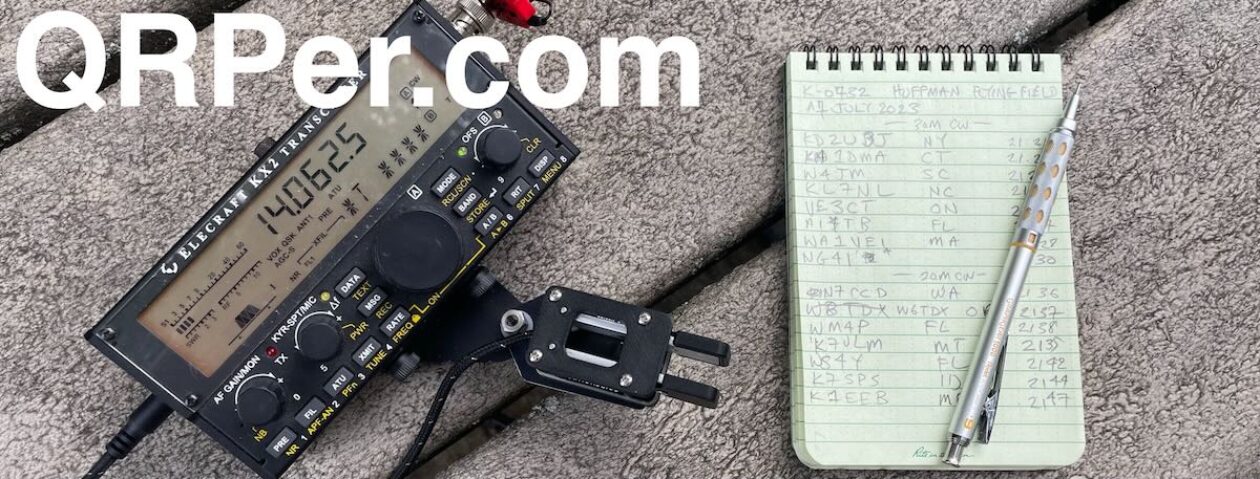My First POTA Adventure
by Alan (WB0ZJJ)
With trepidation, I ventured to Arthur Marshall Loxahatchee National Wildlife Refuge (Boynton Beach, Florida US-0232) with my tiny QRP-Labs QMX radio and CW Morse Pocket Paddle key.

The temperature and humidity were both over 90 (90F and 90% plus). My eye glasses were constantly fogging over as I exited the car to set up a mag-mounted Gabil 7350 antenna atop my Prius Prime, (so I could sit with the A/C cooling and dehumidifying my first ever POTA park adventure).
I adjusted the coax, the counterpoise, and the antenna coil for the best SWR for the 20m QRP frequency of 14.060 MHz, and managed to get it to 1.7:1 this time.

 Next, I setup the station in the back seat of my car. The station consists of:
Next, I setup the station in the back seat of my car. The station consists of:
- QRP-Labs QMX 5W “Mid-band” (60-15m) Radio
- CW Morse Outdoor Pocket Double Paddle
- Bestnule Professional Steel Bench Block
- Anker Soundcore Mini Powered Speaker (wired)
- Cable Matters Retractable Aux Cables
- TalentCell 3000mAh Li-Ion Battery
- DROK variable power buck
- Apple iPad Mini using an iPhone hotspot
- Folding “TV Table” across the seat
 The Prius Prime has an 11 KWh battery which will allow sitting with the A/C set on 75F for many hours without needing the gas engine to run.
The Prius Prime has an 11 KWh battery which will allow sitting with the A/C set on 75F for many hours without needing the gas engine to run.
A little about me – a year ago I was reading the Sci-Fi book “SevenEves” by Neal Stephenson where a miner’s daughter saved humanity because she knew Morse code. I decided I wanted to refresh my CW and get back on the air, (under no illusions I could save humanity).
I successfully built the QRP-Labs QMX rig, participated in the CW Academy Fundamentals class, and became CW buddies with Tim – VA3UZ.
Tim is very active in POTA and helped prepare me for hunting and the “icing-on-the-cake” situation of park-to-park contacts while hunting from a POTA park.
Fully setup in my car at Arthur R Marshall Loxahatchee National Wildlife Refuge, I started my iPad VoiceRecorder app, and scanned the Pota.app spots page for 20m CW activators, tuning the radio for each one until I could hear a strong signal.
The band condition was terrible, sounding like a snoring dragon was eating my speaker, but there was a readable signal on 14.044 MHz. The app said W4TRA was in US-2743 North Carolina, and I heard “CQ POTA CQ POTA W4T<missed chars> K” screaming along at 19 WPM.
I paddled my call out at 15 WPM hoping, but also fearing, my south Florida QRP signal would make it to North Carolina.
From deep in the snoring dragon I could just barely hear “??”, so I sent my call again and waited to see if the question marks were for me or someone else.
Oh boy, I heard my call, caught “TU” and then suffered complete panic as the dits and dahs suddenly were passing faster than my brain could swallow.
Only from the recording could I later learn they sent:
“WB0ZJJ TU UR 22N 22N BK”
When I heard the “BK”, I relaxed somewhat to send my formulated park-to-park response:
“TU UR 559 FL FL P2P P2P US 0232 US 0232 BK”
(Thankful that I didn’t make any sending mistakes!)
It was a great relief when I heard “BK RR”. They continued sending but I only caught “TU” and my call from: “BK RR US0232 TU <fading WB0ZJJ DE W4TRA K>” (per the recording).
After a moment I could just barely pick out “CQ” from the snoring dragon and breathed a dragon size sigh of relief. My very first park-to-park adventure was complete.
Summary
This first foray into POTA was brief, but definitely memorable. After that initial park-to-park contact, I managed one more QSO—a “cell-phone assisted” two-fer with my CW study buddy in Canada. Conditions were so rough that I could only complete it because I already knew his call and park numbers, and had him on the phone to confirm what I was hearing. Not exactly a habit I plan to get into, but it worked!
Shortly after, the thunder started getting a little too close for comfort, so I broke camp. Two QSOs total—one solid, one barely legit—but that first park-to-park was enough to make the outing a win in my book.
My confident CW copy is only around 10 WPM, and every QSO feels like a full cardio workout. I made six during the Florida QSO Party over two days and felt like I needed a week to recover! But this first POTA adventure was a big step forward, and I’m already looking forward to the next one.
Alan (WB0ZJJ)

















































































